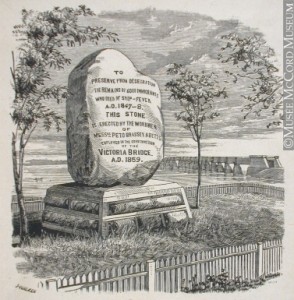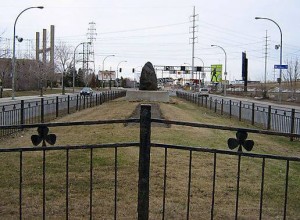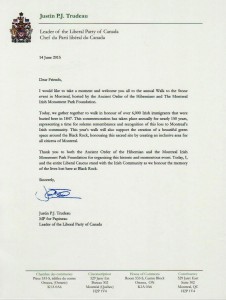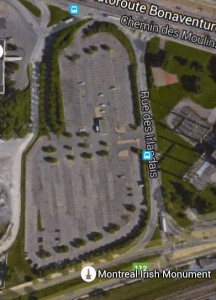
While the Victoria Bridge was being constructed around 1859, workmen discovered a mass grave that contained human remains. The remains were of the Irish immigrants who fled the famine in Ireland only to be affected by typhus or ship fever between 1847-1848. Those who were affected by typhus on their journey to Montreal were dropped off on an Island called Grosse- Ile in Quebec. For those who arrived in Montreal, they were quarantined in fever sheds and those who perished were hastily buried in mass graves. Many religious figures, the grey nuns for example, had helped those who were affected by the disease only to die by it as well. It is estimated that 6000 immigrants, who were mostly of Irish decent, died of typhus in fever sheds situated in Windmill Point, commonly known as Goose Village, not too far from the Victoria Bridge. In order to commemorate the thousands Irish immigrants who died of typhus, the workmen took a boulder from the Saint-Lawrence River, which became the “Irish Commemorative stone of Montreal” situated on Bridge Street on route 112 .
Today, the only living memory that connects to the Irish who died of typhus is the Black Rock that is situated in between two busy roads. The problem is mainly the location of the rock. Since it is situated on a small island on route 112, those who drive past don’t know what the significance of the big boulder in between the road is and the only description of the rock is on a small plaque across the road from the monument. Though the Irish community in Pointe Saint Charles organizes annual walks to the Commemorative Stone, the hope is to expand the awareness of the monument and why it is important to the larger Montreal community. The dream is to create a green space across from the monument, replacing the parking lot into a commemorative park. This green space will not only commemorate the Irish who died of typhus, but will also commemorate important Irish figures as well as remembering the Natives who occupied the land before Colonial occupancy. The goal of commemorating Irish figures and the natives is to show the importance and influence of the Irish in Montreal’s history as well as not forgetting the Indigenous people who occupied the land beforehand.
In the end, the Irish Commemorative Stone, though a symbol for the Irish who escaped the Famine in Ireland only to die of typhus on their arrival to Montreal, can be a symbol for the present day immigrants who sacrificed their lives in order to find a better one and the unknown risks they are willing to take to find a better life.




http://www.montrealirishmonument.com
Interview from Breakfast Television Montreal about the walk to the Irish Commemorative Stone













